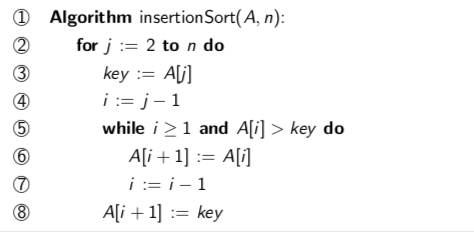Data Structures & Algorithms
Table of Contents
Insertion sort
like sorting a hand of cards sequence is a sorted part followed by an unsorted part
algorithm:
- initially: sorted is only 1 element
- loop: while non-sorted has elements
- insert first element of unsorted part in correct position of sorted part
pseudocode:

analysis:
| line | description | constant |
|---|---|---|
| 1 | nothing | |
| 2 | n operations | constant1 n |
| 3 | n-1 operations | constant2 (n-1) |
| 4 | n-1 operations | constant3 (n-1) |
| 5 | worst case if A[i] > key always true for fixed j we do the test j times: $\sum_{j=2}^{n}=\frac{n(n+1)}{2}-1$ | $\text{constant}_4(\frac{1}{2}(n(n+1))-1)$ |
| 6 | same, j-1 times assignment | $\text{constant}_5(\frac{1}{2}(n-1)n)$ |
| 7 | same, j-1 times assignment | $\text{constant}_6(\frac{1}{2}(n-1)n)$ |
| 8 | n-1 operations | $\text{constant}_7 (n-1)$ |
sum all the constants, results in T(n) of form $an^2+bn+c$.
We have an² ≤ T(n), so T is in ϴ(n²). therefore the algorithm is quadratic time complexity.